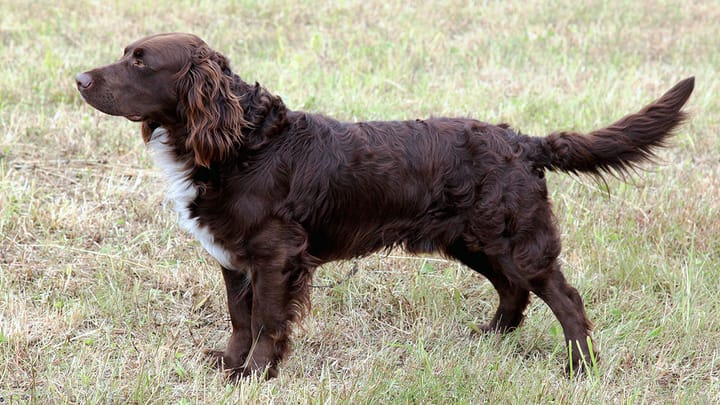German Spaniel
Other names : Deutscher Wachtelhund, German Quail Dog

The German Spaniel was developed around 1890. It was bred to be a hunting dog and is closely related to an old German breed called the Stoeberer, which translates as “rummager.” Although it remains fairly unknown outside of Germany, it was recognised by the UK Kennel Club in 1996. It has that classic spaniel look - short, compact body with long, pendulous ears. An extremely friendly and social dog, they make excellent family pets. A perfect companion for younger children.
|
Life expectancy |
The German Spaniel has a life expectancy of between 12 and 14 years |
|
Temperament |
|
|
Size |
Medium
|
|
Adult size |
Female
Between 18 and 20 in
Male
Between 19 and 21 in
|
|
Adult weight |
Female
Between 40 and 55 lb
Male
Between 40 and 55 lb
|
|
Coat colour
Variations of brown, red, and roan. Can have white markings on the chest and/or legs. |
Brown |
|
Type of coat
Close fitting undercoat. Long, silky topcoat. Wavy, especially around the belly and legs. |
Long |
|
Eye colour
Dark orange. |
Brown
|
|
Purchase price |
The German Spaniel costs between £900 and £1100 |
The German Spaniel is a sensitive dog. They must be reared gently, with a strong emphasis on rewarding good behaviour rather than punishing “bad” behaviour. Because of their placid natures, they can easily get overwhelmed by bigger and more aggressive dogs.
Teaching the recall command is essential. This dog likes to explore. If they pick up on an interesting scent, they can follow it for hours.
More details about the German Spaniel
German Spaniel: Origins and history
A German breeder named Frederick Roberth has been credited for developing the German Spaniel. He developed it by crossing water dogs and sporting spaniels with an ancient German breed called the Stoeberer. The Stoeberer was thought to have as good of a nose as the Bloodhound, which explains the German Spaniels excellent tracking abilities. It was first registered by the German Kennel Club in 1901. In the 1960s, a handful were exported to Northern America and Canada, where they still work alongside professional hunters and gamekeepers.
Physical characteristics of the German Spaniel
Medium sized. Long-haired. Muscular frame. Classic spaniel look. Long pendulous ears. Soft, friendly expression.
FCI classification of the German Spaniel
-
Group 8 - Retrievers - Flushing Dogs - Water Dogs
-
Section 2 : Flushing Dogs
German Spaniel: Characteristics
German Spaniel: Behaviour
Training a German Spaniel
Very easy to train, even for the novice dog handler. Responds really well to reward-based training methods based around positive praise.
German Spaniel: Lifestyle
Breed compatibility German Spaniel
German Spaniel: Purchase price
The initial cost of a German Spaniel puppy is between £900 to £1,100. The average cost to keep one of these dogs (including vet bills, insurance, and food) is between £70 to £80 a month.
German Spaniel: Grooming
Despite its dense coat, this breed is fairly easy to groom. A quick brush every few days will keep it in good shape.
German Spaniel: Health
A very healthy, well-bred dog with a life expectancy of 12 to 14 years.
A strong, well-balanced dog. Robust frame. Bred to track game through rugged countryside and dense forest.
Due to their heavy shedding, the German Spaniel is quite comfortable during the summer months.
They have a thick, double-layered coat that provides protection against the cold, the rain, and the wind.
This dog has a huge appetite and will eat much more than it needs. Keep their food intake within the recommended amounts.


